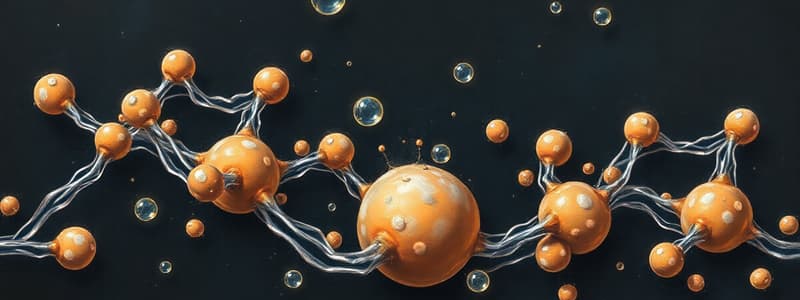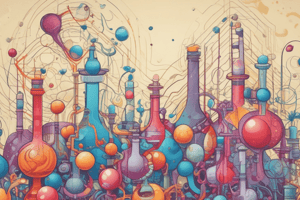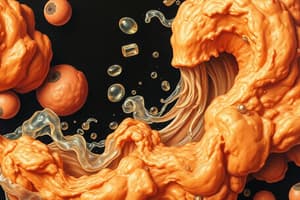Podcast
Questions and Answers
Which protein is responsible for storing iron within the body?
Which protein is responsible for storing iron within the body?
- Albumin
- Collagen
- Myosin
- Ferritin (correct)
Which protein is responsible for transporting oxygen in the blood?
Which protein is responsible for transporting oxygen in the blood?
- Lipase
- Insulin
- Fibrinogen
- Hemoglobin (correct)
Which type of protein is involved in immune responses?
Which type of protein is involved in immune responses?
- Transport Proteins
- Defensive Proteins (correct)
- Enzymatic Proteins
- Structural Proteins
Which of the following is NOT a structural protein?
Which of the following is NOT a structural protein?
Which protein is responsible for maintaining osmotic pressure in blood?
Which protein is responsible for maintaining osmotic pressure in blood?
Which type of protein is primarily soluble in alcohol?
Which type of protein is primarily soluble in alcohol?
What is the primary goal of homology search in sequence analysis?
What is the primary goal of homology search in sequence analysis?
What is the non-protein component of a conjugated protein called?
What is the non-protein component of a conjugated protein called?
Which of the following techniques is NOT used in sequence analysis?
Which of the following techniques is NOT used in sequence analysis?
Which of these is a characteristic of lipoproteins
Which of these is a characteristic of lipoproteins
What is the main goal of multiple sequence alignment?
What is the main goal of multiple sequence alignment?
Which of the following tools is commonly used for homology search?
Which of the following tools is commonly used for homology search?
What is the purpose of domain and motif prediction in sequence analysis?
What is the purpose of domain and motif prediction in sequence analysis?
What is a key difference between ab initio prediction and homology-based prediction in structure prediction?
What is a key difference between ab initio prediction and homology-based prediction in structure prediction?
What is the primary purpose of phylogenetic analysis in sequence analysis?
What is the primary purpose of phylogenetic analysis in sequence analysis?
Which of the following is NOT a method used in structure prediction?
Which of the following is NOT a method used in structure prediction?
What is the definition of a protomer?
What is the definition of a protomer?
Which of the following is NOT an example of a protomer?
Which of the following is NOT an example of a protomer?
Which type of protein would most likely be found in connective tissues like tendons and ligaments?
Which type of protein would most likely be found in connective tissues like tendons and ligaments?
Which of the following is NOT a property of globular proteins?
Which of the following is NOT a property of globular proteins?
Which of the following proteins is involved in the transport of oxygen in the blood?
Which of the following proteins is involved in the transport of oxygen in the blood?
Which of the following is an example of a conjugated protein?
Which of the following is an example of a conjugated protein?
What is the primary function of membrane proteins?
What is the primary function of membrane proteins?
Which of the following is an example of a protein that acts as a receptor?
Which of the following is an example of a protein that acts as a receptor?
Which bioinformatics tool is used for protein family identification?
Which bioinformatics tool is used for protein family identification?
What is the primary function of UniProtKB?
What is the primary function of UniProtKB?
Which of the following is an ab initio protein structure prediction server?
Which of the following is an ab initio protein structure prediction server?
What is the role of MODELLER in protein analysis?
What is the role of MODELLER in protein analysis?
Which database contains experimentally determined protein structures?
Which database contains experimentally determined protein structures?
How can bioinformatics be used in drug discovery?
How can bioinformatics be used in drug discovery?
What is the significance of using bioinformatics in disease diagnosis?
What is the significance of using bioinformatics in disease diagnosis?
Which of the following is NOT a bioinformatics tool mentioned in the content?
Which of the following is NOT a bioinformatics tool mentioned in the content?
Which of the following is NOT a type of interaction that stabilizes tertiary protein structure?
Which of the following is NOT a type of interaction that stabilizes tertiary protein structure?
What is the main difference between parallel and antiparallel β-sheets?
What is the main difference between parallel and antiparallel β-sheets?
Which of the following is TRUE about tertiary protein structure?
Which of the following is TRUE about tertiary protein structure?
What is the role of hydrophobic interactions in tertiary protein structure?
What is the role of hydrophobic interactions in tertiary protein structure?
Which of the following is an example of a protein that contains β-sheets in its structure?
Which of the following is an example of a protein that contains β-sheets in its structure?
What is the primary function of secondary protein structures, like β-sheets and α-helices?
What is the primary function of secondary protein structures, like β-sheets and α-helices?
How can misfolding of secondary protein structures lead to disease?
How can misfolding of secondary protein structures lead to disease?
Which of the following is NOT a factor that can influence protein folding?
Which of the following is NOT a factor that can influence protein folding?
What is the primary principle behind SDS-PAGE?
What is the primary principle behind SDS-PAGE?
Which of the following is NOT a step involved in SDS-PAGE?
Which of the following is NOT a step involved in SDS-PAGE?
What is the purpose of using SDS in SDS-PAGE?
What is the purpose of using SDS in SDS-PAGE?
What type of gel is used in SDS-PAGE?
What type of gel is used in SDS-PAGE?
How does the application of an electric field aid in the separation of proteins in SDS-PAGE?
How does the application of an electric field aid in the separation of proteins in SDS-PAGE?
What is the primary function of denaturation in SDS-PAGE?
What is the primary function of denaturation in SDS-PAGE?
Why is it important to use a polyacrylamide gel in SDS-PAGE?
Why is it important to use a polyacrylamide gel in SDS-PAGE?
What is the typical outcome of SDS-PAGE?
What is the typical outcome of SDS-PAGE?
Flashcards
Glycoproteins
Glycoproteins
Proteins that have carbohydrate components attached to them.
Lipoproteins
Lipoproteins
Complexes of proteins and lipids, involved in transporting cholesterol.
Metalloproteins
Metalloproteins
Proteins that contain metal ions, essential for various functions.
Structural Proteins
Structural Proteins
Signup and view all the flashcards
Transport Proteins
Transport Proteins
Signup and view all the flashcards
Enzymatic Proteins
Enzymatic Proteins
Signup and view all the flashcards
Antibodies
Antibodies
Signup and view all the flashcards
Albumins
Albumins
Signup and view all the flashcards
Homology Search
Homology Search
Signup and view all the flashcards
Domain and Motif Prediction
Domain and Motif Prediction
Signup and view all the flashcards
Multiple Sequence Alignment
Multiple Sequence Alignment
Signup and view all the flashcards
Phylogenetic Analysis
Phylogenetic Analysis
Signup and view all the flashcards
Ab Initio Prediction
Ab Initio Prediction
Signup and view all the flashcards
BLAST
BLAST
Signup and view all the flashcards
Conserved Regions
Conserved Regions
Signup and view all the flashcards
Evolutionary Trees
Evolutionary Trees
Signup and view all the flashcards
SDS-PAGE
SDS-PAGE
Signup and view all the flashcards
Denaturation
Denaturation
Signup and view all the flashcards
Negative Charge in Electrophoresis
Negative Charge in Electrophoresis
Signup and view all the flashcards
Polyacrylamide Gel
Polyacrylamide Gel
Signup and view all the flashcards
Electric Field in Electrophoresis
Electric Field in Electrophoresis
Signup and view all the flashcards
Process of Loading Proteins
Process of Loading Proteins
Signup and view all the flashcards
Molecular Weight
Molecular Weight
Signup and view all the flashcards
Purpose of SDS-PAGE
Purpose of SDS-PAGE
Signup and view all the flashcards
Protomer
Protomer
Signup and view all the flashcards
Heterotetramer
Heterotetramer
Signup and view all the flashcards
Hemoglobin
Hemoglobin
Signup and view all the flashcards
Fibrous Proteins
Fibrous Proteins
Signup and view all the flashcards
Globular Proteins
Globular Proteins
Signup and view all the flashcards
Simple Proteins
Simple Proteins
Signup and view all the flashcards
Conjugated Proteins
Conjugated Proteins
Signup and view all the flashcards
Chaperonin (GroEL)
Chaperonin (GroEL)
Signup and view all the flashcards
HMMER
HMMER
Signup and view all the flashcards
MODELLER
MODELLER
Signup and view all the flashcards
I-TASSER
I-TASSER
Signup and view all the flashcards
UniProtKB
UniProtKB
Signup and view all the flashcards
PDB
PDB
Signup and view all the flashcards
Drug Discovery
Drug Discovery
Signup and view all the flashcards
Disease Diagnosis
Disease Diagnosis
Signup and view all the flashcards
Bioinformatics Applications
Bioinformatics Applications
Signup and view all the flashcards
β-Sheets
β-Sheets
Signup and view all the flashcards
Function of β-Sheets
Function of β-Sheets
Signup and view all the flashcards
Misfolding Consequences
Misfolding Consequences
Signup and view all the flashcards
Tertiary Structure
Tertiary Structure
Signup and view all the flashcards
Hydrophobic Interactions
Hydrophobic Interactions
Signup and view all the flashcards
Hydrogen Bonds
Hydrogen Bonds
Signup and view all the flashcards
Ionic Bonds
Ionic Bonds
Signup and view all the flashcards
Disulfide Bridges
Disulfide Bridges
Signup and view all the flashcards
Study Notes
- Biochemistry is the study of chemical processes within and relating to living organisms.
- Proteins are complex molecules composed of amino acids.
- Proteins perform diverse functions including structural support, regulation, contraction, protection, transport, storage, membrane integration, enzymatic activity, and toxin formation.
- Proteins play crucial roles in metabolism, movement, immune defense, cellular communication, and molecular recognition.
- The building blocks of proteins are amino acids.
- In all known life, 22 amino acids are genetically encoded (proteinogenic).
- Of these, 20 are part of the standard genetic code, while two are selenocysteine and pyrrolysine.
- Glycine, Alanine, Valine, Leucine, Isoleucine, Proline, Glutamate, Glutamine, Aspartate, Asparagine, Lysine, Histidine, Arginine, Phenylalanine, Tryptophan, Tyrosine, Serine, Cysteine, Threonine, and Methionine are the 20 standard amino acids.
- Amino acids have a common structural formula, differing only in their R-groups (functional side chains).
- Amino acids exhibit chirality, meaning they exist as L- and D- isomers.
- All amino acid residues are in the L-stereoisomer in proteins.
- Amino acids can be classified into five groups based on the properties of their side chains (R groups).
- Nonpolar aliphatic amino acids include glycine, alanine, valine, leucine, isoleucine, methionine, and proline.
- Aromatic amino acids include phenylalanine, tyrosine, and tryptophan.
- Polar, uncharged amino acids include serine, threonine, cysteine, asparagine, and glutamine.
- Acidic amino acids include glutamic acid and aspartic acid.
- Basic amino acids include lysine, arginine, and histidine.
- Uncommon amino acids are not naturally encoded in the genetic code, but play roles in various biological functions.
- Examples of uncommon amino acids include hydroxylysine, hydroxyproline, selenocysteine, and pyrrolysine.
- Amino acids function as both acids and bases (amphoteric), existing as zwitterions (dipolar ions) at physiological pH.
- The isoelectric point (pI) is the pH at which an amino acid exists in its zwitterionic form with no net electrical charge.
- Amino acids undergo various chemical reactions, including those with ninhydrin, carboxylic acids, oxidation of cysteine, decarboxylation, and deamination.
- Peptides, oligopeptides, polypeptides, and proteins are different lengths of amino acid chains linked by peptide bonds.
- Proteins have diverse structures – fibrous and globular; based on their arrangement.
- Fibrous proteins are elongated, insoluble, and provide structural support (e.g., collagen, keratin).
- Globular proteins are compact, spherical, water-soluble, and involved in dynamic processes (e.g., enzymes, hemoglobin).
- Protein separation techniques can be used for fractionation.
- Techniques like centrifugation, dialysis, and chromatography (size-exclusion, ion-exchange, affinity) separate proteins.
- Electrophoresis (SDS-PAGE, IEF, and 2-DE) are used to separate proteins based on their properties (size, charge).
- Spectrophotometry is a technique that measures the absorbance of light by a solution.
- The Beer-Lambert Law describes the relationship between absorbance, concentration, and path length of light.
- Methods used in protein analysis can include mass spectrometry, identifying protein modifications.
- Key bioinformatics techniques used in understanding proteins include sequence analysis, homology searching, domain and motif prediction, multiple sequence alignment, phylogenetic analysis, and protein structure prediction (ab initio and homology modeling).
- Protein structure is crucial for function, and misfolded proteins are linked to diseases.
- Various tests including the Biuret, Xanthoproteic, Ninhydrin, Millon's, Hopkins-Cole, Sakaguchi, and Pauly's tests, can be used to identify or quantify amino acids and/or proteins, or to identify their functional groups.
- Quantitative methods like Lowry and Bradford assays are used to estimate protein concentration in solutions.
- Kjeldahl test is used for quantifying nitrogen in proteins.
- Protein denaturation disrupts the native structure of a protein losing function from the alteration in its noncovalent interactions.
- Denaturation arises from various factors like pH changes, mechanical agitation, chemical agents, and heat.
Studying That Suits You
Use AI to generate personalized quizzes and flashcards to suit your learning preferences.




